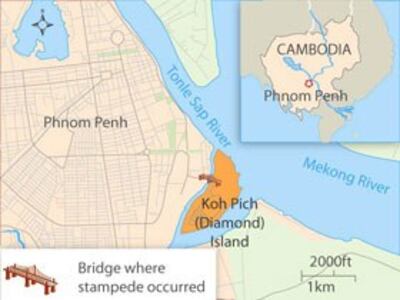The death toll in a massive stampede at an annual water festival in Cambodia's capital has increased to more than 350 as teeming hospitals cope with a flood of injuries in the country's worst tragedy in recent years.
Officials said that at least 353 people were killed in the Nov. 22 stampede on a narrow, overcrowded bridge, while an additional 755 people, mostly women, were left injured and in need of medical care at Phnom Penh hospitals. They said the death count is likely to increase in coming days.
Government spokesman Phay Siphan denied reports that the stampede was sparked by panicked festival-goers who had suffered electric shocks from a network of neon lights set up on the bridge for the celebration.
"The cause was panic, not electrocution," he said, adding that some people allegedly shouted that the bridge was going to collapse.
The 80-meter (263-feet) bridge links Phnom Penh to the entertainment-filled Diamond Island packed with restaurants, fairground rides, and exhibition centers.
An investigation into the circumstances that led to the tragedy is ongoing.
Prime Minister Hun Sen, who called the tragedy the worst loss of life in Cambodia since the Khmer Rouge regime killed nearly two million people in the 1970s, said officials would conduct autopsies to assist in the inquiry.
Day of mourning
The prime minister declared Nov. 25 a day of national mourning and promised that the families of each dead victim would receive 5 million riel (U.S. $1,250) for funeral expenses, while the injured would receive 1 million riel (U.S. $250) each.
He said the government would arrange for the bodies of out-of-town visitors to be sent home. Soon after, 13 military trucks began taking away corpses from Calmette Hospital in downtown Phnom Penh.
Nhim Vanda, the deputy president in charge of Cambodia’s national disaster response who has led the investigation into the disaster, said families had already begun holding funerals for the dead.
“Most of the dead have already been taken by their families from the hospitals and brought for cremation, though some still remain at the hospital,” he said.
“Some of the victims died on the way the hospital, some were alreadydead, and some died right after arriving at the hospital. Right nowthere are about 150 victims still at the hospital,”Nhem Sopheun, Calmette Hospital deputy director said.
The hospital had been filled to capacity and many of the injured had to be treated in the hallways.
Youth among the dead

Most of the dead were younger revelers, including students, garment factory workers, and construction workers from Cambodia’s Kandal, Kampong Cham, Svay Rieng, and Prey Veng provinces.
A student named Chariya sat crying in front of Calmette Hospital over her classmate, Tin Ny.
Tin Ny, who Chariya described as an “outstanding” 20-year-old student who had received a scholarship from the International School of Foreign Language, died near her on the bridge, but she could do nothing to save him.
“I saw his face—he is my close friend. I always used to call on him whenever I had something I needed to talk about, but now he is dead.”
Narrow bridge
Questions remain over why authorities had earlier shut down a second pedestrian route along a bridge for vehicles driving onto Diamond Island or Koh Pich, located at the confluence of the Mekong and Tonle Sap rivers off the coast of Phnom Penh.
Festival-goers who had entered the island via that route, and who had tried to exit the island by using the only other bridge following the last boat race of the three-day water festival, found themselves walking into another stream of revelers trying to access the island for evening events.
After several pedestrians lost consciousness in the ensuing crush, rumors of an electric shock or bridge collapse further fueled panic and led to a stampede, during which many were crushed underfoot or pushed off of the bridge into the water below.
Police sprayed water on the crowd of people wedged into the narrow path of the bridge in an effort to quench the thirst of those who had survived but could not free themselves.
Rescuers combed the area, seeking out the injured and stacking dead bodies for removal to makeshift morgues.
Authorities said that the large majority of the deaths were due to suffocation and internal injuries, adding that nearly two-thirds of the dead were women.
Officials had estimated that around two million people would attend the Bon Om Touk festival in Phnom Penh, which marks the end of Cambodia’s rainy season and features traditional boat races, fireworks, and concerts along the river.
Reported by Tin Zakariya for RFA’s Khmer service with contributions from news agencies. Written in English by Joshua Lipes.
